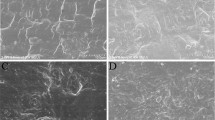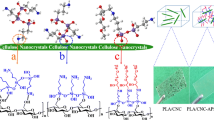Abstract
In this research, the dopamine self-polymerization was used to coat polydopamine (PDA) on cellulose nanocrystal (CNC) surfaces, and we integrated the functionality and structural merits of the two components in poly(vinyl alcohol) (PVA) films at a nanometer scale. The results showed that coating PDA on CNCs led to a concurrent increase in strength and break elongation. With increasing PDA@CNC loading level, the Young’s modulus continuously increased, which could be ca. 3.1-fold over that of neat PVA film at a loading level of 15 wt%. Both tensile strength and breaking elongation of the nanocomposite reached the maximum values with 6 wt% PDA@CNC, which were 75.8% and 58.1% more than those of neat PVA, respectively. Besides, the maximum decomposition temperature shifted from 271.3 °C of neat PVA film to 278.5 °C of the nanocomposite containing 6 wt% PDA@CNC, and then was continuously elevated up to 328.2 °C when the PDA@CNC loading level reached 15 wt%. For packaging application, the PDA component contributed to the UV-shielding and radical-scavenging functions, and the PDA@CNC nanofiller reduced the permeability of oxygen and water–vapor into PVA-based composites. Overall, the integrated PDA@CNC nanofiller as an active ingredient enhanced the mechanical, thermal, and functional properties of the PVA-based materials, and hence intensified the potential of their packaging application.







Similar content being viewed by others
References
Abdullah ZW, Dong Y, Davies IJ, Barbhuiya S (2017) PVA, PVA blends, and their nanocomposites for biodegradable packaging application. Polym Plast Technol 56:1307–1344
Alin J, Hakkarainen M (2011) Microwave heating causes rapid degradation of antioxidants in polypropylene packaging, leading to greatly increased specific migration to food simulants as shown by ESI-MS and GC–MS. J Agric Food Chem 59:5418–5427
Aloui F, Ahajji A, Irmouli Y, George B, Charrier B, Merlin A (2007) Inorganic UV absorbers for the photostabilisation of wood-clearcoating systems: comparison with organic UV absorbers. Appl Surf Sci 253:3737–3745
Brinchi L, Cotana F, Fortunati E, Kenny JM (2013) Production of nanocrystalline cellulose from lignocellulosic biomass: technology and applications. Carbohydr Polym 94:154–169
Chao C et al (2013) Surface modification of halloysite nanotubes with dopamine for enzyme immobilization. ACS Appl Mater Interface 5:10559–10564
Chao C, Zhang B, Zhai R, **ang X, Liu J, Chen R (2014) Natural nanotube-based biomimetic porous microspheres for significantly enhanced biomolecule immobilization. ACS Sustain Chem Eng 2:396–403
Fortunati E et al (2012) Multifunctional bionanocomposite films of poly(lactic acid), cellulose nanocrystals and silver nanoparticles. Carbohydr Polym 87:1596–1605
French AD (2013) Idealized powder diffraction patterns for cellulose polymorphs. Cellulose 21:885–896
Fukuzumi H, Saito T, Iwata T, Kumamoto Y, Isogai A (2009) Transparent and high gas barrier films of cellulose nanofibers prepared by TEMPO-mediated oxidation. Biomacromol 10:162–165
Ghelichkhah Z, Sharifi-Asl S, Farhadi K, Banisaied S, Ahmadi S, Macdonald DD (2015) L-cysteine/polydopamine nanoparticle-coatings for copper corrosion protection. Corros Sci 91:129–139
Hakalahti M, Salminen A, Seppala J, Tammelin T, Hanninen T (2015) Effect of interfibrillar PVA bridging on water stability and mechanical properties of TEMPO/NaClO2 oxidized cellulosic nanofibril films. Carbohydr Polym 126:78–82
Hambardzumyan A, Foulon L, Chabbert B, Aguiébéghin V (2012) Natural organic UV-Absorbent coatings based on cellulose and lignin: designed effects on spectroscopic properties. Biomacromol 13:4081–4088
Han Y, Wu X, Zhang X, Zhou Z, Lu C (2016) Dual functional biocomposites based on polydopamine modified cellulose nanocrystal for Fe3+-pollutant detecting and autoblocking. ACS Sustain Chem Eng 4:5667–5673
Huang S et al (2013) Complexes of polydopamine-modified clay and ferric ions as the framework for pollutant-absorbing supramolecular hydrogels. Langmuir 29:1238–1244
Kim JH et al (2015) Review of nanocellulose for sustainable future materials. Int J Precis Eng Manuf Green Technol 2:197–213
Lee H, Dellatore SM, Miller WM, Messersmith PB (2007) Mussel-inspired surface chemistry for multifunctional coatings. Science 318:426–430
Li L, Bao RY, Gao T, Liu ZY, **e BH, Yang MB, Yang W (2019) Dopamine-induced functionalization of cellulose nanocrystals with polyethylene glycol towards poly(L-lactic acid) bionanocomposites for green packaging. Carbohydr Polym 203:275–284
Lin N, Huang J, Chang PR, Feng JW, Yu JH (2011) Surface acetylation of cellulose nanocrystal and its reinforcing function in poly(lactic acid). Carbohydr Polym 83:1834–1842
Lin N, Huang J, Dufresne A (2012) Preparation, properties and applications of polysaccharide nanocrystals in advanced functional nanomaterials: a review. Nanoscale 4:3274–3294
Liu W et al (2013) Embedding dopamine nanoaggregates into a poly(dimethylsiloxane) membrane to confer controlled interactions and free volume for enhanced separation performance. J Mater Chem A 1:3713–3723
Lopez DDC, Nerin C, Alfaro P, Catala R, Gavara R, Hernandez-Munoz P (2011) Development of new antioxidant active packaging films based on ethylene vinyl alcohol copolymer (EVOH) and green tea extract. J Agric Food Chem 59:7832–7840
Miltz J, Rosen-Doody V (2010) Migration of styrene monomer from polystyrene packaging materials into food simulants. J Food Process Preserv 8:151–161
Narayanan KB, Han SS (2017) Dual-crosslinked poly(vinyl alcohol)/sodium alginate/silver nanocomposite beads—a promising antimicrobial material. Food Chem 234:103–110
Peng Z, Kong LX (2007) A thermal degradation mechanism of polyvinyl alcohol/silica nanocomposites. Polym Degred Stabil 92:1061–1071
Phua SL, Yang L, Toh CL, Guoqiang D, Lau SK, Dasari A, Lu X (2013) Simultaneous enhancements of UV resistance and mechanical properties of polypropylene by incorporation of dopamine-modified clay. ACS Appl Mater Interface 5:1302–1309
Prataviera R, Pollet E, Bretas RES, Averous L, Lucas AA (2018) Nanocomposites based on renewable thermoplastic polyurethane and chemically modified cellulose nanocrystals with improved mechanical properties. J Appl Polym Sci 135:46736
Sa R, Yan Y, Wei Z, Zhang L, Wang W, Tian M (2014) Surface modification of aramid fibers by bio-inspired poly(dopamine) and epoxy functionalized silane grafting. ACS Appl Mater Interface 6:21730–21738
Salam A, Lucia LA, Jameel H (2013) A novel cellulose nanocrystals-based approach to improve the mechanical properties of recycled paper. ACS Sustain Chem Eng 1:1584–1592
Santamaria-Echart A, Ugarte L, Garcia-Astrain C, Arbelaiz A, Corcuera MA, Eceiza A (2016) Cellulose nanocrystals reinforced environmentally-friendly waterborne polyurethane nanocomposites. Carbohydr Polym 151:1203–1209
Shang Y, Peng Y (2007) Research of a PVA composite ultrafiltration membrane used in oil-in-water. Desalination 204:322–327
Shende P, Oza B, Gaud RS (2018) Silver-doped titanium dioxide nanoparticles encapsulated in chitosan–PVA film for synergistic antimicrobial activity. Int J Polym Mater Polym Biomater 67:1080–1086
Siripatrawan U, Harte BR (2010) Physical properties and antioxidant activity of an active film from chitosan incorporated with green tea extract. Food Hydrocoll 24:770–775
Sonkaew P, Sane A, Suppakul P (2012) Antioxidant activities of curcumin and ascorbyl dipalmitate nanoparticles and their activities after incorporation into cellulose-based packaging films. J Agric Food Chem 60:5388–5399
Theapsak S, Watthanaphanit A, Rujiravanit R (2012) Preparation of chitosan-coated polyethylene packaging films by DBD plasma treatment. ACS Appl Mater Interface 4:2474–2482
Wu X, Lu C, Zhang X, Zhou Z (2015) Conductive natural rubber/carbon black nanocomposites via cellulose nanowhisker templated assembly: tailored hierarchical structure leading to synergistic property enhancements. J Mater Chem A 3:13317–13323
Xu Q et al (2014) Polydopamine-coated cellulose microfibrillated membrane as high performance lithium-ion battery separator. RSC Adv 4:7845–7850
Yang C-C, Lee Y-J (2009) Preparation of the acidic PVA/MMT nanocomposite polymer membrane for the direct methanol fuel cell (DMFC). Thin Solid Films 517:4735–4740
Yang J, Han C-R, Zhang X-M, Xu F, Sun R-C (2014a) Cellulose nanocrystals mechanical reinforcement in composite hydrogels with multiple cross-links: correlations between dissipation properties and deformation mechanisms. Macromolecules 47:4077–4086
Yang Y, Shapter JG, Popelka-Filcoff R, Bennett JW, Ellis AV (2014b) Copper removal using bio-inspired polydopamine coated natural zeolites. J Hazard Mater 273:174–182
Youssef AM, El-Sayed SM, Salama HH, El-Sayed HS, Dufresne A (2015) Evaluation of bionanocomposites as packaging material on properties of soft white cheese during storage period. Carbohydr Polym 132:274–285
Yu Z, Li B, Chu J, Zhang P (2018) Silica in situ enhanced PVA/chitosan biodegradable films for food packages. Carbohydr Polym 184:214–220
Zehetmeyer G, Soares RMD, Brandelli A, Mauler RS, Oliveira RVB (2012) Evaluation of polypropylene/montmorillonite nanocomposites as food packaging material. Polym Bull 68:2199–2217
Zemljič LF, Tkavc T, Vesel A, Šauperl O (2013) Chitosan coatings onto polyethylene terephthalate for the development of potential active packaging material. Appl Surf Sci 265:697–703
Zhao D, Lei Q, Qin C, Bai X (2012) Biocomposites reinforced with cellulose nanocrystals derived from potato peel waste. Carbohydr Polym 90:709–716
Acknowledgments
This work was supported by the National Natural Science Foundation of China (51373131) and Talent Project of Southwest University (SWU115034).
Author information
Authors and Affiliations
Corresponding authors
Ethics declarations
Conflict of interest
The authors declare no competing financial interest.
Additional information
Publisher's Note
Springer Nature remains neutral with regard to jurisdictional claims in published maps and institutional affiliations.
Electronic supplementary material
Below is the link to the electronic supplementary material.
Rights and permissions
About this article
Cite this article
Liu, S., Chen, Y., Liu, C. et al. Polydopamine-coated cellulose nanocrystals as an active ingredient in poly(vinyl alcohol) films towards intensifying packaging application potential. Cellulose 26, 9599–9612 (2019). https://doi.org/10.1007/s10570-019-02749-7
Received:
Accepted:
Published:
Issue Date:
DOI: https://doi.org/10.1007/s10570-019-02749-7




